This corned beef and cabbage is ideal for St. Patrick’s Day but so good you’ll want to make it year-round!
Did you know corned beef is crazy easy to make?! This step-by-step guide will teach you how to cure your own beef brisket to create the best pink, salty, spicy, fall-apart-tender corned beef brisket of your life – way better than store-bought! Of course, if you’re short on time, you can simply follow the cooking instructions for store-bought corned beef. This corned beef recipe is made with beef brisket, pickling spices and kosher salt which cure for 5 days and then roast in the oven with a mustard brown sugar rub with carrots, potatoes and cabbage until tender – it’s essentially a one-pot meal after the curing process! The oven is my preferred cooking method, but I’ve also included instructions for crockpot corned beef, instant pot corned beef and boiled corned beef. Finally, dunk your juicy, tender, succulent corned beef brisket into creamy, tangy horseradish cream sauce and enjoy the perfect bite, after bite….
If you’re fans of beef at your house, corned beef is just the beginning! Try beef tenderloin, skillet steak and potatoes, crazy tender pot roast, beef tips and gravy, slow cooker French dip sandwiches, London broil and marinated flank steak.
Watch How to Cook Corned Beef

PIN THIS RECIPE TO SAVE FOR LATER
YOU’LL LOVE this HOMEMADE CORNED BEEF
I didn’t grow up eating corned beef, but the first year of marriage my husband, Patrick, of Irish descent, introduced me – and we’ve been celebrating St. Patrick’s Day in style ever since. But for us, corned beef isn’t just a once-a-year celebration, we love this corned beef recipe year-round, because it’s not just another boiled corned beef dinner, this is oven roasted corned beef with a subtle mustard brown sugar glaze.
This easy recipe elevates humble ingredients into out of this world delicious. The corned beef is roasted in a savory beef broth until the meat and vegetables are fork tender and dripping with flavor from the spiced bath. The mustard brown sugar glaze is very subtle but adds the extra elevating “oomph” as the sweet tanginess cuts through the rich, robust corned beef brisket. The end result is a corned beef recipe that’s an intoxicating balance of savory, sweet, salty, spicy succulence.
WHAT IS Corned beef?
Corned beef is essentially flat-cut brisket cured in a salt brine with vibrant, pungent pickling spices and pink curing salt which gives it its signature pink color. It was during the 17th century that salted beef was coined “corned beef” by the British to describe the corn-kernel-size salt crystals used to cure the meat during the “corning” process. Corned beef brisket is often sold in the seasoned brining solution, but for the best corned beef, cure it yourself!
Corned beef brisket comes from a relatively inexpensive cut of beef, the underbelly of the cow, behind the front legs (foreshanks) so it’s studded with connective tissue and muscle that supports much of the weight of the cow. This means the beef is extremely tough and needs to be cooked low and slow in order to become buttery tender and flavorful. You can achieve this by cooking the corned beef brisket in the oven, slow cooker or boiling it on the stovetop with the option of adding potatoes, carrots and cabbage to the meat while it’s cooking to create a one-pot dinner.
A plus about corned beef brisket is it holds its shape so you can either slice it OR shred it, unlike chuck roast and short ribs that shred easily when cooked for a long period of time. Why this is important is that you don’t have to worry too much about overcooking your corned beef brisket because it will hold together even when shreddable tender.
Corned Beef Brisket: A Wee Bit O’ History
Is Corned Beef Really Irish?
Corned beef was popularized in Ireland, but not for the Irish. In the 1600s, Ireland produced large amounts of beef for trade, particularly live cattle exported to England. Ironically, beef was too expensive for most Irish to consume so they would purchase ham or bacon if they could afford meat at all.
In the 1660s, England passed laws which prohibited the exportation of live cattle to England. This flooded the Irish market with beef, lowering its cost and increasing availability.
At the same time, Ireland’s salt tax was almost 1/10 that of England’s so they could import the highest quality salt at an inexpensive price. With high quality salt and large quantities of cattle, salted beef became Ireland’s new major export and the best on the market. It didn’t take long for Ireland to be supplying Europe and the Americas with its “corned beef.” By the 18th century, the Irish could comfortably afford meat, and began reaching for corned beef at their own dining tables, but ham and cabbage remained the staple on St. Patrick’s Day.
Corned beef and cabbage became an Irish-American St. Patrick’s Day tradition because corned beef was a less expensive substitute for ham for impoverished immigrants. In honor of their homeland, the immigrants splurged on corned beef (which happened to be Jewish kosher brisket), and served it up with their beloved potato and the most affordable vegetable of the time, cabbage. It didn’t take long for corned beef and cabbage to become synonymous with St. Patrick’s Day in America.
Whether you serve your corned beef and cabbage for St. Patrick’s Day or for delicious day, this corned beef recipe will make the Irish proud!

THREE MAIN STEPS TO MAKING CORNED BEEF
Homemade corned beef brisket does take a little meal planning ahead of time, but the actual process is incredibly easy to make. To make corned beef:
- Make a curing brine with kosher salt and pickling spices like peppercorns, mustard seed, allspice berries and coriander seeds
- Brine the brisket for 5 to 7 days
- Cook the corned beef in the oven for several hours until tender with potatoes, carrots and cabbage for a one pot meal
That’s it, so easy! And the best part is, I’ve done all the experimenting work for you to come up with the best recipe!
THE SECRETS TO MAKING CORNED BEEF
- Using the perfect custom blend of pickling seasonings – and enough of them!
- Toasting the seasonings
- Adding the seasonings to both the brine and the roasting liquid
- Brining for a full 5 days
- Using unsalted beef broth instead of water to cook the brisket in
- Slathering the corned beef with mustard and brown sugar
- Cooking in the oven
- Cooking until fork tender
Now all you have to do is follow this corned beef recipe for the most juicy, rich, flavorful corned beef of your life!
Corned Beef Recipe Ingredients
How Do I Buy Corned Beef?
To make corned beef from scratch, purchase flat beef brisket vs. “point cut” (I get mine at Costco) because it is the most even thickness and won’t shrink. Flat beef brisket will weigh about 5-6 pounds, but the curing salt brine is very forgiving and can accommodate a brisket that weighs more or less. You will just need to make adjustments when it comes to cooking time.
The point cut can work but there will be more shrinkage due to fat rendering out of the meat, so you will need more meat to have the same amount of cooked brisket.
DO NOT purchase “corned beef” at your grocery store because it is already cured in its own pickling spices. You will only want to purchase corned beef if you plan on following the instructions on the package to cook and don’t plan on curing your own brisket.
How to Season Your Corned Beef
Corned beef is not only famous for its pink color, but for its seasonings! Corned beef seasonings create the vibrant, salty, spicy beef we all know and love that gets balanced by the tangy mustard and sweet brown sugar topping added to the roasted brisket.
By making your own corned beef recipe, you can hand pick the seasonings, adding more or less of what you’re partial to. However, I’ve done the experimenting for you, and landed on what I believe to be the perfect spice blend.
Many of these corned beef seasonings can be picked up at the grocery store, or the a la carte bins at Sprouts or Winco, but you may need to order some online, such as juniper berries. I’ve linked the corned beef seasonings below to Amazon for easy purchasing if need be:
- whole black peppercorns: spicy, fresh, tart and aromatic
- whole allspice berries: a complex combination of cloves, cinnamon, and nutmeg
- whole juniper berries: slightly piney with a touch of fruity pepperiness
- coriander seeds: warm, spicy, nutty, aromatic with a hint of citrus
- yellow mustard seeds: slightly pungent, sweet and spicy
- whole cloves: warm, pungent, sweet and bitter
- red pepper flakes: sharp, earthy, spicy
- green cardamom pods: zesty citrus flavor with sweet and spicy notes
- bay leaves: slightly bitter, slightly minty with subtle hints of black pepper and pine
- ground ginger: sweet, peppery and a bit floral, with a hint of citrus
- garlic powder: pungent, warm, earthy and garlicky!
- cinnamon: warm, woody, pungent with subtle sweet and bitter notes
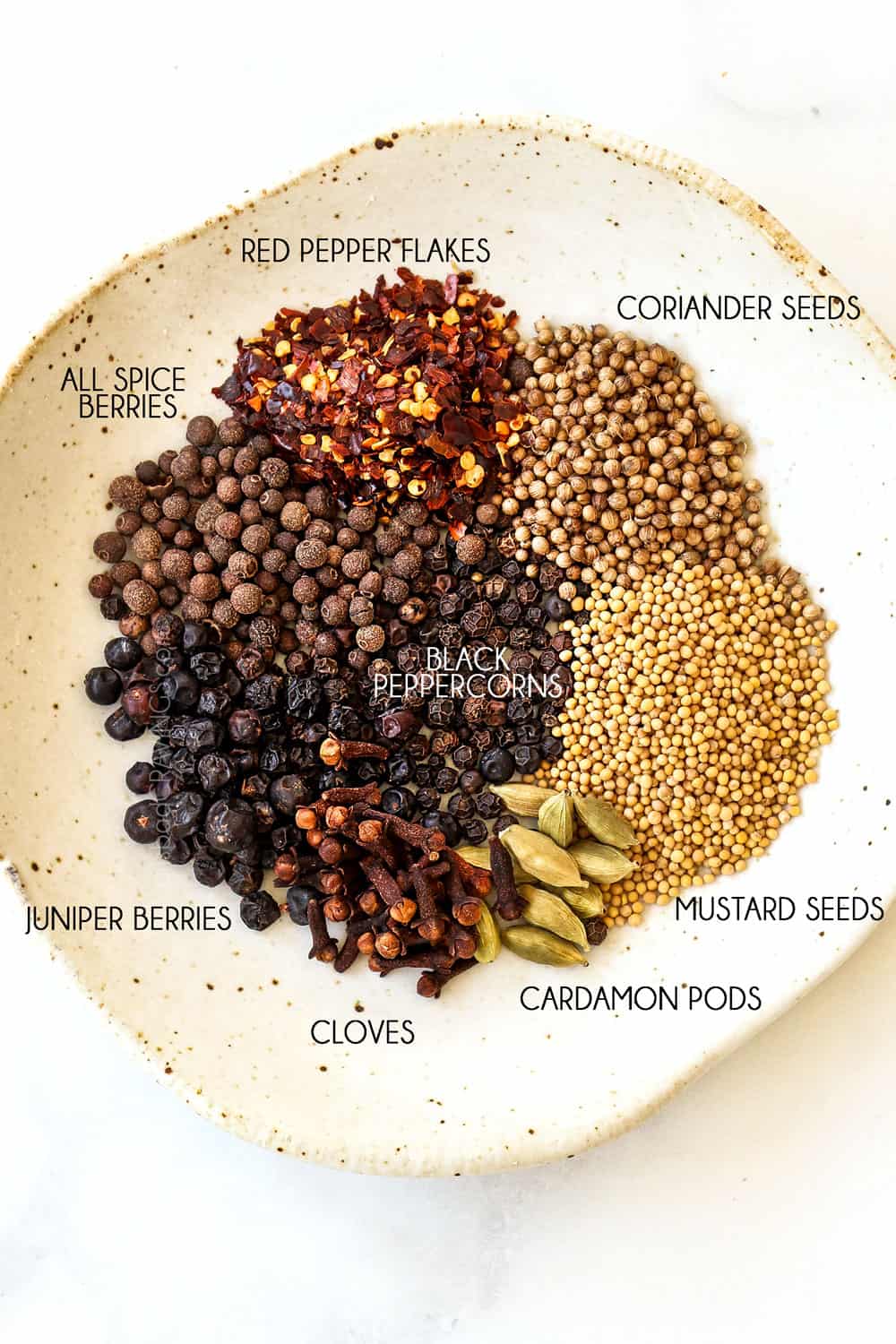
THE IMPORTANCE OF PINK SALT IN MAKING CORNED BEEF
Corned beef would just be cured beef it wasn’t for the characteristic vibrant pink color. Corned beef brisket gets its pink color from the pink curing salt added to the brine. Pink salt is a curing salt containing nitrite. It is colored pink so individuals don’t confuse it with table salt because it should only be consumed in small doses and can be fatal if ingested directly in large quantities. Note, that pink curing salt is NOT Himalayan pink salt!
Pink curing salt serves four purposes:
- Preserves the corned beef’s red color even after curing and makes it “pink”
- Prevents fats from developing rancid flavors during the curing process
- Inhibits bacteria from growing during curing
- Imparts the characteristic flavor of cured meats
Pink curing salt may or may not be sold at your grocery store. You will probably have to purchase it online here. Note that pink salt is sold under various brand names, including: Prague Mix #1, tinted cure mix (or T.C.M.), DQ Curing Salt, Curing Salt #1 and Insta-Cure Salt #1. Do NOT purchase Insta Cure #2 which is used for air-cured meats that aren’t cooked, such as pepperoni, hard salami, dried farmers sausage, capicola, etc.
How much pink salt is necessary to corn beef?
You may notice that your package of pink salt calls for 1 teaspoon per 5 pounds of meat but this recipe calls for 4 teaspoons. This is the standard amount used for curing beef brisket. In this recipe, the pink salt is diluted in an entire gallon of water so it is not nearly as concentrated. It is also only cured for 5 days. Still, you can follow the package directions and only use 1 teaspoon if you are more comfortable, but your corned beef will not be very pink.
Is pink salt safe?
Pink curing salt is roughly 94% salt and 6% nitrate. The sodium nitrite is the ingredient used to cure meats such as bacon, ham, pancetta, and of course corned beef. We are cautioned to consume cured meats sparingly because frequent consumption of cured meats is linked to an increased risk of certain types of cancer. I rarely consume cured meat, so I’m not worried for myself, but you can omit the pink curing salt altogether if you prefer.
Corned Beef without pink salt
The pink curing salt adds color, flavor and helps to preserve the beef but it can be omitted if you only cure the brisket for five days then cook it immediately. You do not want to cure the corned beef for longer than five days if you omit the curing salt.
If you omit the pink salt, your corned beef will be an unappealing, dull grey color. To remedy this you can add 1-2 tablespoons of beetroot powder or ½ cup beet juice to the brine to turn the meat a light pink color.
HOW TO MAKE CORNED BEEF
Corned beef is very easy to make! The only caveat is you have to plan ahead so the brisket can cure for a full 5 days. It also requires some unique seasonings such as juniper berries but once you gather your spices, you’ll be able to use them again and again. I’m going to briefly summarize the process of making corned beef then go into more detail below.
Step 1: Toast the Pickling corned beef seasonings
You can certainly skip this step and use store-bought pickling spices, however, for the best corned beef recipe, I highly recommend this custom blend. Regardless of what you use, you’ll first want to toast the spices in a skillet. Toast them just until fragrant. Once they’ve been toasted, crush them using a mortar and pestle or use the back of a spoon, meat mallet or side of a can.
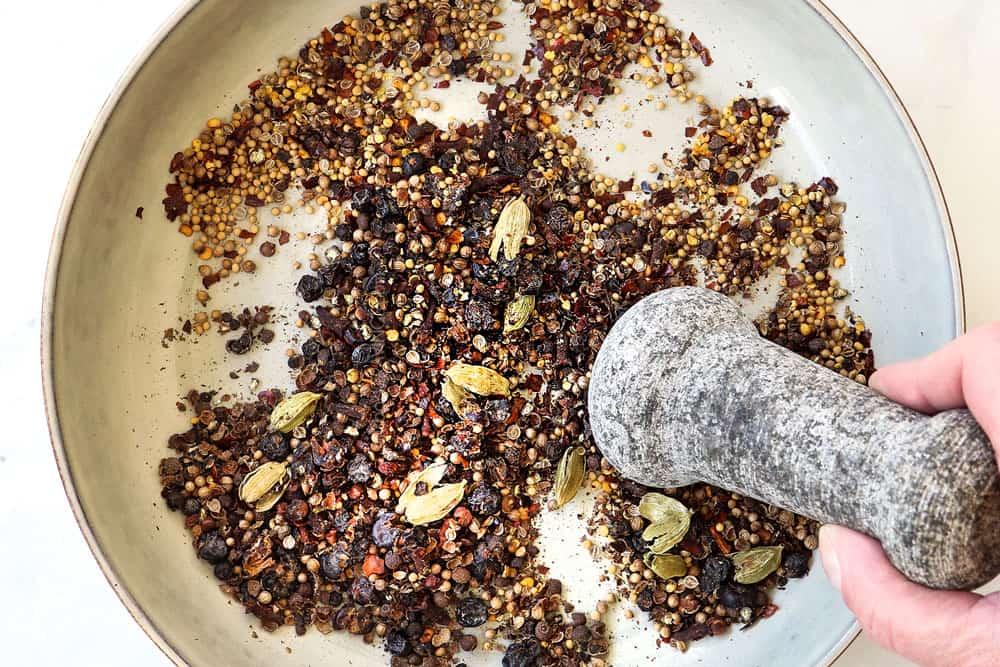
Step 2: Make Curing Brine
In a large stockpot, add a 1 ½ tablespoons of the prepared pickling spices, a cinnamon stick, a gallon of water, salt(s), and sugar. Bring the mixture to a boil, then remove it from the heat and bring it to room temperature. Then, chill in the refrigerator until cold.

Step 3: Brine the Brisket
Once the curing brine is chilled, add the brisket. It will likely float, so you’ll need to weigh it down with a bowl filled with pie weights or cans. Cover and brine the brisket in the refrigerator for 5-7 days.

Step 4: Cook the Corned Beef
Remove the brisket from the brine and rinse under cold water several times to remove excess salt. At this point you have the choice to boil the brisket, cook the brisket in the oven or the crockpot. I will include instructions for each, but I recommend the oven method.
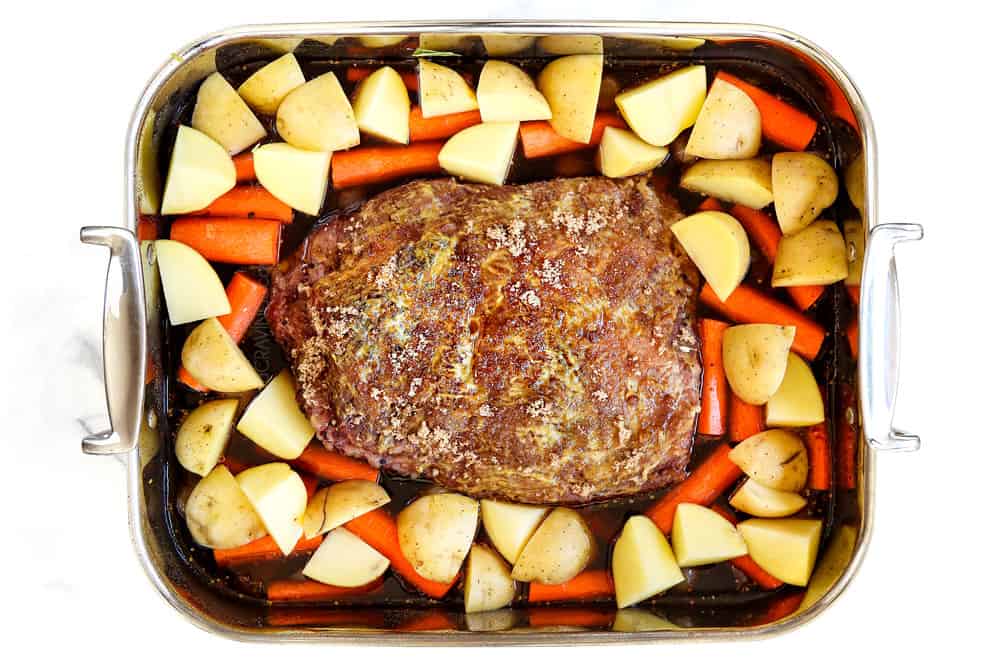
Step 5: slice the Corned Beef brisket
Remove the corned beef brisket to a cutting board and let rest for 10 minutes before slicing against the grain. Serve with horseradish cream sauce or mustard.

Now that you know how to make corned beef, let’s get into the nitty gritty and answer all your possible questions to make this a succulent success.
DO YOU HAVE TO RINSE OFF CORNED BEEF BEFORE COOKING?
Yes, you need to rinse the corned beef from the brine before cooking or it will be too salty. I suggest erroring on the side of over-rinsing because nothing will ruin your meal than one that’s too salty! Once the corned beef brisket has been cured, you’ll remove it from the pot and discard the brine. To rinse, I place the corned beef in the now empty pot and cover it with water. Swoosh the water around, discard the water and repeat.
How to Cook Corned Beef
Boiling corned beef brisket is the most popular method because it is the most traditional, dating back hundreds of years, but that doesn’t make it the best! There are just some things that just shouldn’t be boiled, in my opinion, like ribs and brisket. Boiling brisket unevenly cooks the meat and results in a funky texture and lack of flavor. I will still detail how to boil corned beef below, but it won’t be “the best.”
My favorite method to cook corned beef for optimal flavor and texture is cooking corned beef in the oven. The corned beef briskets simmers in a small amount of beef broth surrounded by potatoes, carrots and cabbage. The all-encompassing, steady, even low temperature of the oven cooks the meat evenly without boiling out the flavor. Here’s how:
Corned Beef in the Oven
- Step 1: Add brisket, beef broth and seasonings to the roasting pan. Transfer brisket to a large roasting pan, fattiest side up. Add about 3 cups unsalted beef broth to fill 1/4-inch up the sides of the corned beef. Stir the reserved 1 1 ½ tablespoons pickling seasonings into the broth. Whisk the Dijon mustard and honey together (NOT brown sugar) and spread half all over the top of the beef.
- Step 2: Roast brisket for a couple hours. Cover the pan tightly with foil and bake for a few hours depending on your brisket size.
- Step 3: Add vegetables and finish baking. After about 2 ½ hours, brush remaining honey mustard over the top of the brisket then sprinkle with brown sugar. Arrange the carrots, potatoes and cabbage in that order, all around the corned beef in the pan. Tightly cover the pan with foil and bake until the beef and vegetables are fork tender.
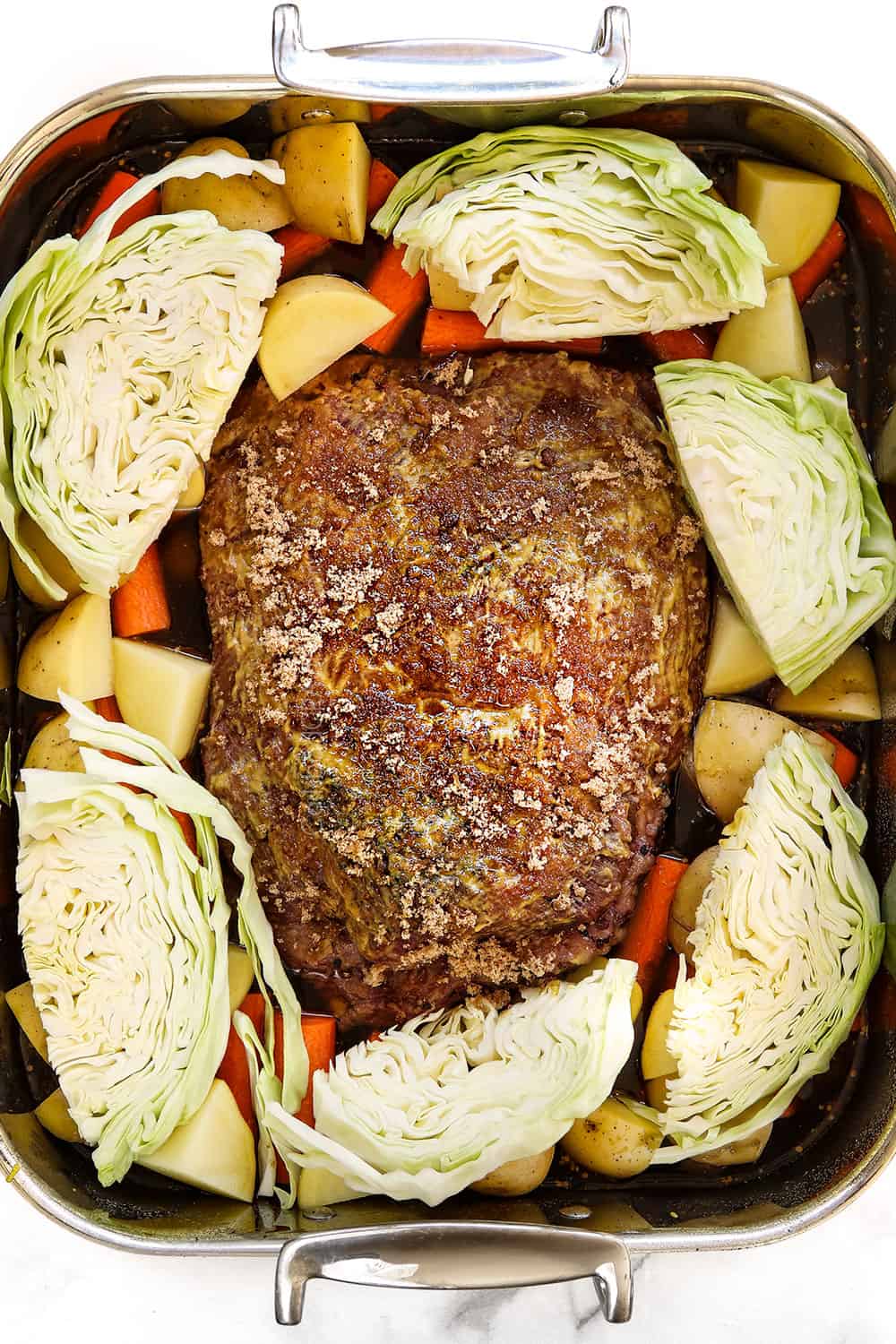
Step 4: Brown the meat. This step is optional to create a crust on the corned beef. Remove the vegetables to a serving platter using a slotted spoon and cover with foil. Increase the oven temperature to 425°F and bake for 10 to 15 minutes, or until the top browns.
WHAT TEMPERATURE SHOULD I COOK CORNED BEEF AT?
Corned beef brisket needs to be roasted low and slow at 350 degrees F so the tough connective tissue and marbling has plenty of time to break down to create juicy, tender brisket. Slow-roasting also means less moisture loss which also creates a juicier beef. Don’t be tempted to crank up the heat in the oven, slow cooker or on the stove.
How Long to Cook Corned Beef in The Oven?
A good rule of thumb is to cook corned beef brisket for 60 minutes per pound of meat at 350 degrees in the oven. For this recipe, the time is broken up: the first half the corned beef cooks alone, the second half the vegetables are added.
You will want to plan on roasting the potatoes and carrots for 2 ½ hours and the rest of the time should be allotted for the brisket to cook alone. So, for a 5 pound brisket, subtract 2 ½ hours for the vegetables to roast, and you are left with 2 ½ hours to roast the brisket first by itself. If you have a 6-pound brisket, subtract 2 ½ hours to roast the vegetables, and you are left with 3 ½ hours to roast the brisket first by itself.
Boiled Corned Beef
- Step 1: Add brisket, beef broth and seasonings to a pot. Use a Dutch oven/pot just large enough to hold the meat like the one you brined it in. Add the rinsed brisket and 1 ½ tablespoons pickling spices. Add unsalted beef broth until it covers the brisket by 1-inch, meaning there is one-inch of liquid above the top of the brisket. If you don’t have enough broth, you can add water.
- Step 2: Simmer brisket. Bring to a boil over high heat, then reduce to low, cover and gently simmer for 3 1/2-4 hours or until the meat is fork tender. You may need to add additional broth or water if it gets too low. Transfer corned beef to a cutting board while you cook the vegetables.
- Step 3: Cook vegetables. Add the carrots and potatoes to the pot. Add additional water so the vegetables are covered by 1-inch liquid. Simmer for 15 minutes, then add the cabbage and continue to cook until the vegetables are fork tender.
Crockpot Corned beef
- Step 1: Add brisket, beef broth and seasonings to crockpot. Spray a 6 quart (or larger) slow cooker with non-stick cooking spray. Transfer rinsed brisket to slow cooker. It will be large so you will have to squish it in or slice it in half. Add enough broth so it comes up ¼ inch up the sides of the brisket. Stir 1 ½ tablespoons reserved pickling spices into the broth. Brush brisket with half of the honey mustard sauce. Add carrots and potatoes on top of the brisket.
- Step 2: Cook corned beef until tender. Cover and cook on LOW for 8-10 hours until brisket is very tender. Add cabbage on top of the carrots and potatoes the last hour of cooking. If your brisket is tough, it just needs to cook longer.
- Step 3: Brown the top. Remove brisket to a foil lined baking sheet. Brush brisket with remaining honey mustard sauce and sprinkle with brown sugar. Broil 5-10 minutes, until slightly caramelized.
Instant Pot Corned Beef
Adapted from Simply Recipes
For the instant pot, you will want to use a 4-pound beef. The brine can stay the same.
- Transfer the corned beef to the Instant Pot, and add 6 cups of unsalted beef broth. Stir in 1 ½ tablespoons reserved seasonings.
- Seal the lid and select the Meat/Stew or Manual setting on your pressure cooker. Set the cooking time for 55 minutes at high pressure. (The pot will take about 20 minutes to come up to pressure before the cooking program starts.)
- When the cooking ends, let the pressure release naturally completely. This will take about 40 minutes. Transfer the beef to a cutting board and tent it with foil.
- If adding vegetables: wear heat-resistant oven mitts, and carefully lift out the inner pot and pour out all but 1 cup of the cooking liquid (or 1 ½ cups if using an 8-quart IP) and return the pot.
- Place a wire mesh steamer basket inside the pot. Place the carrots and potatoes in the steamer basket, and layer the cabbage on top. It’s okay if the vegetables are slightly above the 2/3 “max fill” marking, but they should not be above the rim of the pot where they could block the pressure valve mechanisms in the pressure cooker lid.
- Secure the lid and set the pressure release valve to its sealing position. Cancel the cooking program, then select the Steam program for 4 minutes at high pressure.
- The pot will take about 15 minutes to come up to pressure before the cooking program starts.
- When the cooking program ends, perform a quick pressure release by moving the pressure release valve to its venting position right away, taking care not to get burned by the steam.
Make-Ahead Corned Beef recipe
By nature of this corned beef recipe, you will partially be making it in advance by brining it for 5 days. You can also cook the corned beef a day ahead of time, reserve the cooking broth and refrigerate it separately, then rewarm everything when needed. Here’s how:
Day 1: Cook the meat
- Cook the corned beef and vegetables in the oven according to recipe instructions.
- Transfer beef and vegetables to a platter and cover with foil.
- Store the broth in an airtight container in the refrigerator.
- Store everything in the refrigerator overnight or up to two days.
Day 2 or 3: Warm the meat in the oven
- Preheat the oven to 350 degrees F.
- Slice the brisket and place it back in your large roasting pan and surround it with vegetables, cabbage on top.
- Add about two ladles of broth, cover with foil, and reheat for 20 to 25 minutes, or until hot.
What temperature should corned beef be cooked to?
Thankfully, corned beef brisket is not a temperamental meat and is difficult to overcook because it has a wide “doneness” window. Cook the corned beef to 185-200 degrees F. The closer it gets to 200 degrees, the more fall apart tender it will become. The high internal temperature allows collagen to break down, making the meat melt in your mouth tender.
You don’t want to cook the corned beef brisket past 200F, however, because it can become mushy. Use an instant read meat thermometer to measure the thickest part of the brisket or I’m obsessed with my digital probe thermometer. The thermometer allows you to set the desired temperature for each probe and an alarm will set as soon as it reaches the set temperature.
Note, if you’ve never used a probe thermometer before, the LCD display does NOT go in the oven or barbecue! You insert the probes into the meat and weave the cables out of the oven and the magnetic back allows you to stick it on your oven door or you can use the flip-out countertop stand.
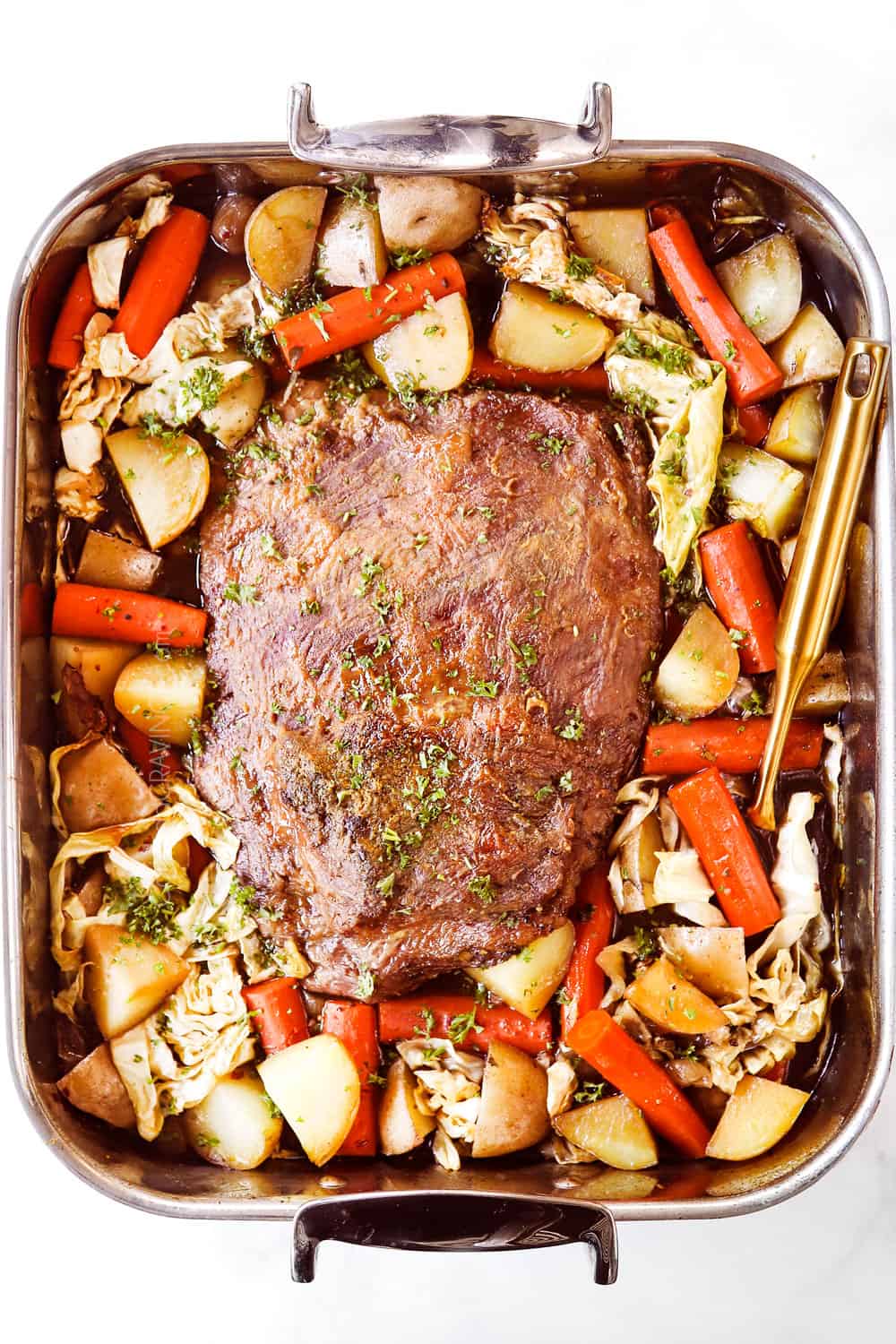
How to slice corned beef brisket across the grain
It is very important to slice corned beef brisket across the grain or it will taste chewy and rubbery. You can see the “grain” running through the meat in one direction. The grain is essentially the muscle fibers bundled together running through the meat. You want to cut perpendicular to the muscle fibers so they become as short as possible. You can a have melt in your mouth corned beef but if you cut it parallel to the grain you will end up with long muscle fibers AKA chewy, rubbery tough meat. So, cut AGAINST the grain!
CORNED BEEF RECIPE TIPS
- Pickling spices: You can either make the homemade pickling spice blend shared in the recipe card below, or you can purchase a store-bought blend. Use whichever you prefer, but of course I’m going to say go for the custom blend if you want the BEST corned beef recipe!
- Weigh the salt rather than measure it out: Weigh the salt using a kitchen scale, if possible. If measuring in cups, the amount of salt you’ll need will vary depending on the brand. This is because different brands of kosher salt have different sizes of salt flakes.
- Brisket: You’ll need a 5–6-pound brisket for this recipe. For the best cut of meat, buy the brisket from the butcher’s counter at your local grocery store.
- Don’t shortcut the brining process: The longer the brisket is left to soak in the brine, the more tender and flavorful it will be! Let the brisket brine for the full 5 days for best results.
- Submerge the brisket in brine: Depending on what container you’re using to brine the brisket; you may need to weigh it down. The meat must be fully submerged in the brine! I use a bowl and fill it with pie weights, but use whatever works for you.
- Use a thermometer! Our ultimate goal is for corned beef that is tender but not falling apart, so use a meat thermometer and shoot for 200 degrees F.
- Let the corned beef brisket rest. After the corned beef reaches 200 degrees, transfer it to a cutting board and let rest for at last 10 minutes before slicing. While the brisket cooks, the juices are forced away from the heat to the middle of the meat. The resting time allows for the redistribution and reabsorption of the juices throughout the whole corned beef. If you slice the brisket prematurely, the juices will rush out and it won’t be as juicy.
- Slice the meat against the grain: After the brisket has cooked, it should be very easy to see lines on top of the meat. That’s called the grain of the meat. You want to slice the brisket against the grain for the most tender bite.
HOW TO SERVE HOMEMADE CORNED BEEF
Transfer the sliced corned beef brisket to a big platter. Surround it with the cabbage, potatoes, and carrots. Ladle some of the broth into a bowl, but resist the urge to pour it over the platter. The corned beef and veggies will already be quite flavorful, and if you add additional broth, they might be too spicy for some. Allow individuals to dress their own brisket and veggies with broth if they desire. Alternatively, you can strain the broth so it’s not as spicy.
Serve corned beef and cabbage with sublime horseradish cream sauce (highly recommend!) and/or with the mustard of your choice. The zesty horseradish cream sauce is intoxicating. It’s cool and creamy with a gentle zippiness from the horseradish and brightness from the lemon juice that beautifully balances, contrasts and cuts through the richness of the corned beef without overpowering it. Best of all, it’s so easy to make! Simply whisk sour cream, mayonnaise, horseradish, lemon juice and chives in a bowl-that’s it!
Parsley Sauce – An Irish favorite
In Ireland, corned beef is served with a parsley sauce which is essentially a white sauce made with lots of chopped parsley. To make, melt 2 tablespoons butter in a saucepan over medium heat. Add 2 tablespoons flour and cook for 1 minute. Add ¾ milk, 2 tablespoons minced fresh parsley, 1 ½ teaspoons mustard and a pinch of nutmeg. Simmer gently until thickened, about 4-5 minutes, then season with salt and pepper to taste
Corned beef brisket SERVING SIZE
Wondering how many people your corned beef brisket will serve? It’s very subjective because it depends on if you have small or big eaters (adults, verses children verses growing teenagers), and what sides you’re serving with the corned beef. Are you serving just the potatoes, carrots and cabbage or supplementing with a salad, fruit, bread, etc.? Less sides will mean more brisket per person, more sides will mean less brisket per person.
Taking these variables into consideration, the recommended serving size for corned beef per person is ¾ lb. of uncooked flat brisket (point brisket will shrink more). So, a 5-pound brisket will serve 6.6 people. If you aren’t quite sure how much you need, it’s always better to have leftover beef than not have enough – plus that way you can make corned beef hash!
What to Serve with Corned Beef Brisket?
Corned beef is usually served with carrots, potatoes, and cabbage. You can keep things traditional, or you can serve variations of these veggies. Here are some ideas:
- Potatoes: Garlic Mashed Potatoes, Garlic Butter Smashed Potatoes, Crockpot Mashed Potatoes, Baked Parmesan Fingerling Potatoes.
- Carrots: Glazed Carrots and Honey Roasted Carrots.
- Other Veggies: Roasted Broccoli, Roasted Butternut Squash, Roasted Brussels Sprouts, Roasted Root Vegetables or Roasted Carrots, Sauteed Brussels Sprouts, Glazed Carrots or Brown Butter Balsamic Asparagus.
- Salads: Wedge Salad, Green Bean Salad, Spinach Berry Salad, Strawberry Salad and Cucumber Tomato Salad, Apple Salad, Fall Salad, Roasted Butternut Squash Salad and Roasted Beet Salad.
- Fruit Salads: Perfect Fruit Salad, Creamy Grape Salad, Pina Colada Fruit Salad, Winter Fruit Salad and Berry Salad in Honey Mascarpone Dressing.
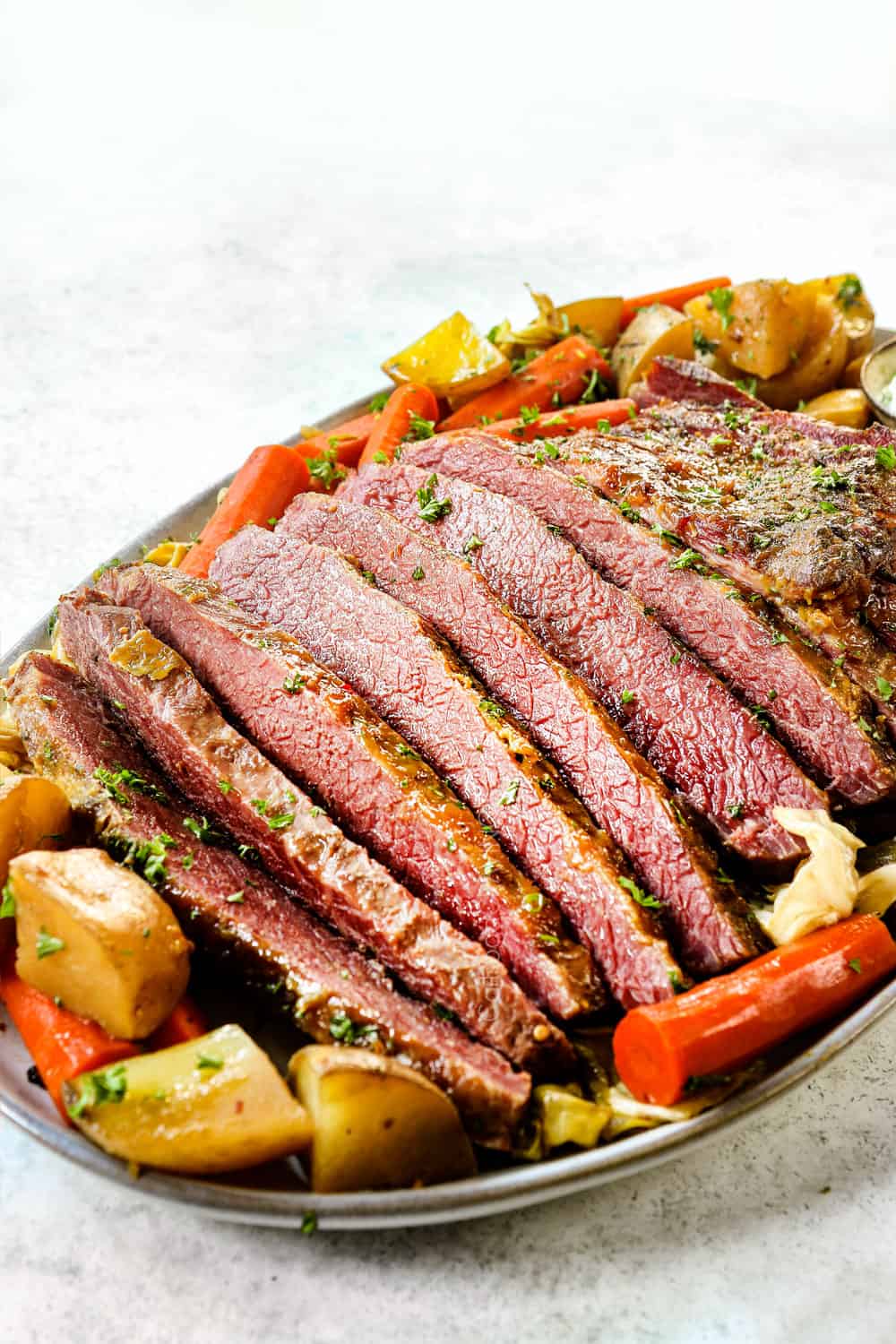
STORING AND REHEATING
- Storage: Store corned beef and cabbage in an airtight container for up to 5 days in the fridge.
- To reheat on the stovetop: Bring a small amount of water or beef broth to a simmer in a skillet. Add the sliced beef, cover, and let simmer over low heat for a few minutes to warm through.
- To reheat in the oven: Pour a couple ladles of water (or better yet strained reserved cooking liquid if you have it) into the bottom of a roasting pan or smaller dish depending on leftover size. Add the sliced corned beef and cover tightly with foil. Reheat at 350 degrees F for about 20 minutes, just until warmed through.
- To reheat in the crockpot: Add the corned beef followed by the vegetables (cabbage on top) to the slow cooker and reheat on LOW for 1-2 hours until warmed through.
How to Freeze Corned Beef
Let the corned beef cool completely in the fridge. Wrap the whole corned beef or portioned slices tightly in plastic wrap, then transfer to a freezer bag, squeeze out excess air and seal. Freeze for up to 3 months. When ready to eat, thaw overnight in the fridge before reheating.
Ways to Use Up Leftover Corned Beef
Should you be so lucky to have leftover corned beef, you can use it in corned beef hash or simply add it to scrambled eggs, omelette, frittata or quiche. It can also be used to make the famous grilled cheese Rueben sandwich with Swiss cheese, sauerkraut, and Russian dressing or make your own beef sandwich with your favorite fixings.
Leftover corned beef recipe can also be chopped up and added to any pasta such has Million Dollar Macaroni and Cheese, soup such has Cabbage Soup or the Best Baked Beans
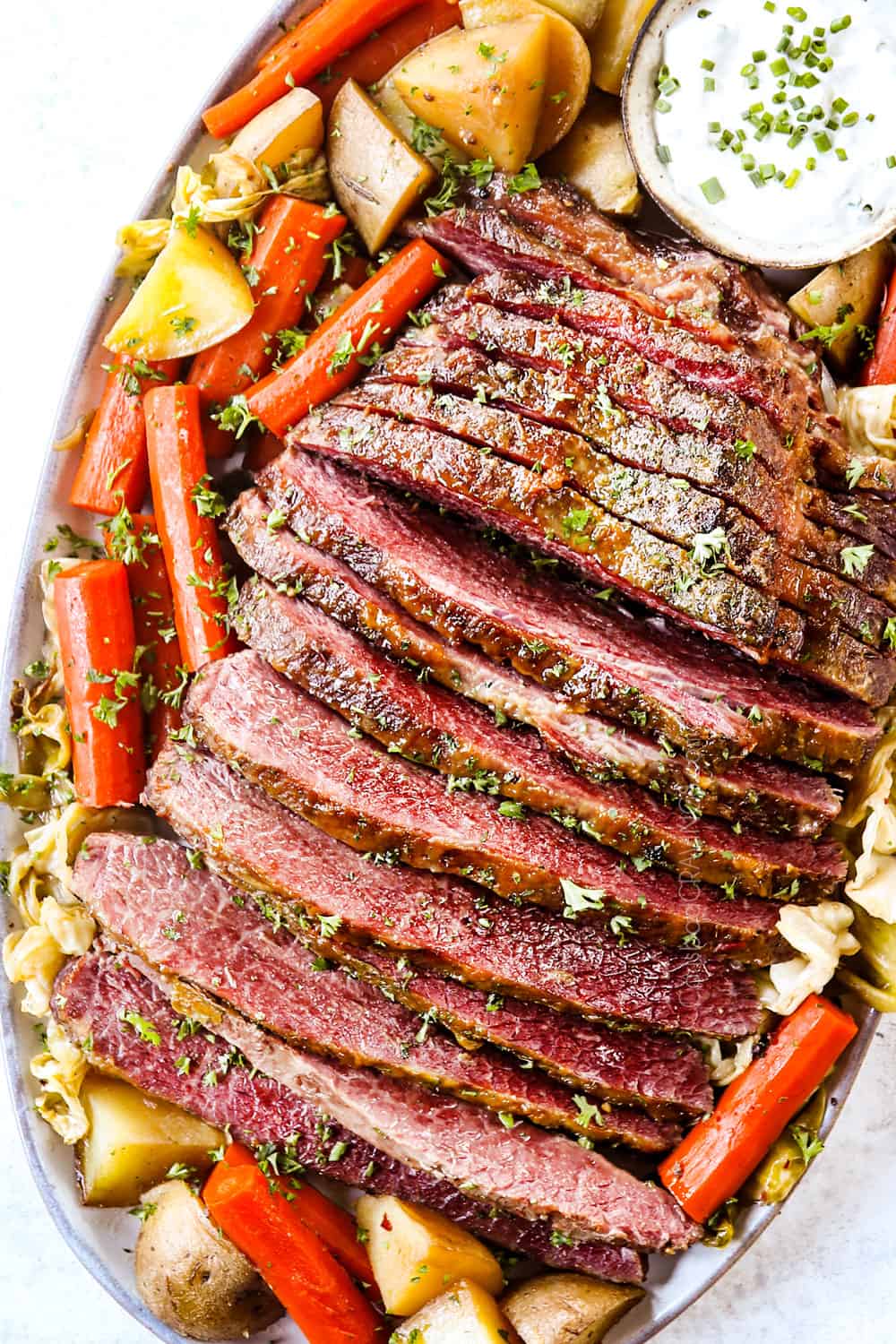
Corned Beef Recipe FAQs
This comes down to personal preference. I followed Alton Brown’s lead on this one and trimmed the beef, including most of the fat cap. Some argue that the fat cap renders during cooking and bastes the brisket, but I find this isn’t necessary because the corned beef has already been marinating for five days – it is plenty juicy!
If you leave thicker fat on the pork, it will be trimmed off anyway before eating, along with any caramelization. Instead, we’re going to slather the top of the trimmed corned beef brisket with honey mustard and a sprinkling of brown sugar which creates an appetizing, flavorful crust verses a mouth of fat that has to be trimmed.
I suggest sticking with horseradish sauce rather than gravy. Regardless, DO NOT use the leftover liquid from the pan to make gravy. The leftover drippings from the beef brisket will be far to pungent and spicy.
Both corned beef and pastrami look and taste similar, but they are not interchangeable. Readers have asked if they can make pastrami from this corned beef recipe. You will want to cure the corned beef per the recipe, then add a rub to the corned beef and smoke it.Here’s what makes corned beef and pastrami similar and what sets them apart:
Origin: Corned beef is from Ireland which is why it’s the quintessential meal on St. Patrick’s Day. Pastrami is either Romanian where it derived from pastrama, which was made with pork or mutton; or Turkish where it derived from pastirma, made with beef.
Cut of beef: Both corned beef and pastrami can be made with beef brisket, but more often pastrami is either made from a cut called the deckle, a lean, wide, firm shoulder cut, or the navel, a smaller and juicier section right below the ribs.
Curing: Both meats are cured in a salt brine seasoned with similar pickling spices such as peppercorns, mustard seeds, juniper berries, cloves and cardamon to infuse the meat with flavor and tenderness. Both brines also include pink curing salt which makes the meat pink.
Seasoning: This is what really sets pastrami and corned beef apart. Corned beef is left naked other than the pickling spices whereas cured pastrami is coated in a mixture of seasonings such as pepper and coriander, etc. that gives it its blackened appearance.
Cooking technique: Corned beef is typically boiled (although I’m showing you the tastier oven roasting method today), whereas pastrami is smoked over hardwood then steamed.
Corned beef is typically made from the brisket cut of beef, which comes from the lower chest area of the cow. This cut is cured in a brine solution, often containing salt, sugar, and various spices, and then slow-cooked to tenderize the tough meat. The term “corned” comes from the large grains of salt, known as “corns,” used in the curing process. Corned beef is a popular ingredient in various dishes, including the traditional Irish-American meal of corned beef and cabbage.
Yes, you can overcook corned beef. When corned beef is cooked for too long, especially at high temperatures, the meat can become tough and chewy instead of tender and flavorful. This happens because the collagen that breaks down during cooking to make the meat tender eventually breaks down completely, leaving the meat dry and stringy. To avoid overcooking, it’s best to cook corned beef slowly at a low temperature just until tender.
Looking for More Beef Dinner Recipes?
- Beef Tenderloin
- Balsamic Slow Cooker Roast Beef
- Slow Cooker French Dip Sandwiches
- Braised Short Ribs
- Crockpot Beef Barbacoa
- London Broil
- Marinated Flank Steak
- Mom’s Crazy Tender Baked Pot Roast
- All of my beef recipes!
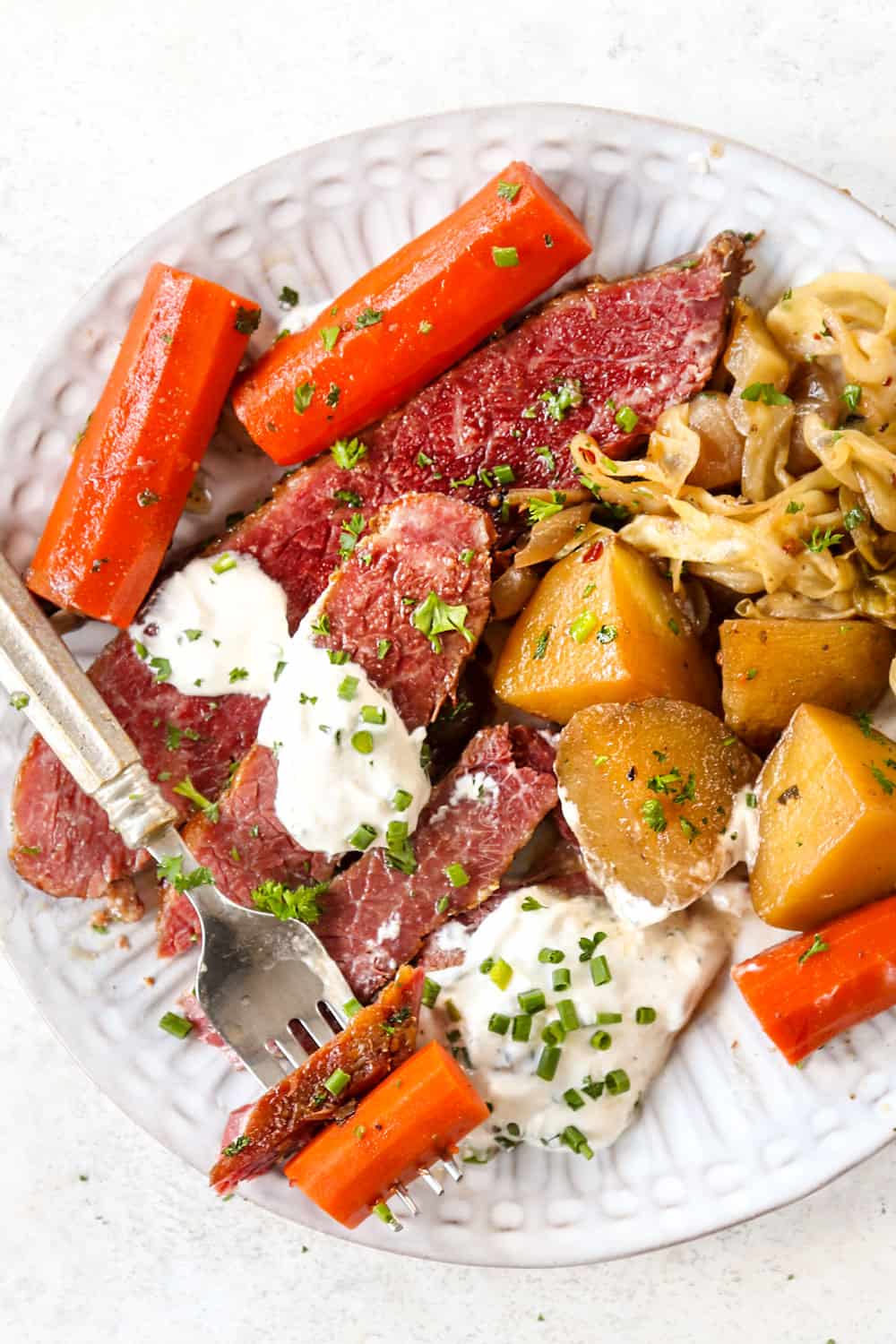

Homemade Corned Beef
Save This Recipe To Your Recipe Box
You can now create an account on our site and save your favorite recipes all in one place!
Ingredients
Pickling spices
- 2 teaspoons whole black peppercorns
- 2 teaspoons whole allspice berries
- 2 teaspoons whole juniper berries
- 2 teaspoons whole coriander seeds
- 2 teaspoons whole yellow mustard seeds
- 2 teaspoons red pepper flakes
- 2 teaspoons whole cloves
- 8 whole green cardamom pods
Add later:
- 4 large bay leaves crumbled
- 1 teaspoons ground ginger
- 1 teaspoon garlic powder
Brine
- 1 5-6 pound flat beef brisket
- 300 g Kosher salt (1 cup 3 ½ TBS of Morton's Kosher Salt OR 2 cups of Diamond Crystal brand Kosher Salt
- 1/2 cup packed brown sugar
- 4 teaspoons pink curing salt optional, see Recipe Notes
- 1 cinnamon stick broken into several pieces
- 1 gallon water (16 cups/3.8 liters)
TO ROAST (veggies are optional)
- 2-3 cups UNSALTED beef broth, more or less as needed
- 8 ounces pearl onions, peeled (optional)
- 3 tablespoons Dijon mustard
- 1 tablespoons honey
- ¼ cup light brown sugar
- 1 ½ -2 lbs. medium carrots, peeled and cut into thirds
- 1 ½ – 2 pounds medium Yukon Gold potatoes, quartered (about 1 1/2-2 inch wedges)
- 1/2 head green cabbage, cut into ½ inch slices
For Serving
- 1 Recipe Horseradish Cream Sauce << click for recipe (highly recommend!)
- Dijon mustard (optional)
Instructions
Prepare pickling spices:
- Add pickling spices up through cardamon pods to a medium frying pan. Toast over medium heat just until fragrant, about 3 minutes (Don’t burn!).
- Transfer spices to a mortar or medium bowl. Use a pestle, meat mallet or side of a knife or can to coarsely crush the spices. Stir in the crumbled bay leaves, ground ginger and garlic powder.
Make brine:
- Remove 1 ½ tablespoons pickling spices to an airtight container/sandwich bag to store for later (you will use these when roasting). Add remaining pickling spices to a large Dutch oven. Add Kosher salt, brown sugar, pink curing salt, cinnamon and a gallon of water.
- Cover to bring to a boil, then remove from heat. Let cool to room temperature then refrigerate until chilled (cooling can take several hours).
Brine brisket
- Once the brine is chilled, add the brisket. Weigh the brisket down so it's completely submerged in the brine with a bowl filled with pie weights or cans. Cover and brine the brisket in the refrigerator for 5-7 days.
Rinse Corned Beef
- Remove brisket from brine; discard brine. To rinse, add brisket back to the pot and cover with water. Repeat 3-4 times to remove excess salt.
Oven Roasted Corned Beef (Recommended)
- Preheat oven to 350 degrees F.
- Transfer brisket to a large roasting pan, fattiest side up. Add 2-3 cups unsalted beef broth to fill 1/4-inch up the sides of the pan. Stir the reserved 1 ½ tablespoons pickling seasonings into the broth.
- Whisk the Dijon and honey together (NOT brown sugar) and spread half all over the top of the beef. Add pearl onions if using. Cover the pan tightly with foil and bake at 350 degrees F for 2 ½ hours. If your brisket is closer to 6 pounds, then roast for 3 ½ hours.
- After 2 ½ hours (3 ½ hours for 6 lb. brisket), remove the pan from the oven and very carefully remove the foil starting with the opposite end (step away because it will steam a lot). Brush remaining honey mustard over the top of the beef then sprinkle with brown sugar. Arrange the carrots, potatoes and cabbage, in that order, all around the brisket in the pan (you want the potatoes perched on top of the carrots so they’re not swimming in broth).
- Tightly cover the pan with foil and bake an additional 2 1/2-3 hours or until the beef registers 185-200 degrees F and vegetables are fork tender. For spicy cabbage, submerge it in the broth the last 10 minutes of cooking.
- Optional: Brown the meat. Remove vegetables to a serving platter using a slotted spoon and cover with foil. Broil the brisket on high (550F) for 5-10 minutes until the top is slightly caramelized.
- Transfer corned beef to a cutting board and tent with foil. Let rest for 10 minutes before slicing across the grain. Serve with horseradish cream sauce (recipe coming Thursday!) and/or mustard.
Alternate Cooking Methods
Boiled Corned Beef
- Use a Dutch oven/pot just large enough to hold the meat like the one you brined it in. Add the rinsed brisket and 1 ½ tablespoons pickling spices. Add unsalted beef broth until it covers the brisket by 1-inch, meaning there is one-inch of liquid above the top of the brisket. If you don’t have enough broth, you can add water.
- Bring to a boil over high heat, then reduce to low, cover, and gently simmer for 4 hours or until the meat is fork tender. You may need to add additional broth or water if it gets too low. Transfer corned beef to a cutting board while you cook the vegetables.
- Add the carrots and potatoes to the pot. Add additional water so the vegetables are covered by 1-inch liquid. Simmer for 15 minutes, then add the cabbage and continue to cook until the vegetables are fork tender.
Crockpot Corned beef
- Spray a 6 quart (or larger) slow cooker with non-stick cooking spray. Transfer rinsed brisket to slow cooker. It will be large so you will have to squish it in or slice it in half. Add enough broth so it comes up ¼ inch up the sides of the brisket. Stir 1 ½ tablespoons reserved pickling spices into the broth. Brush brisket with half of the honey mustard sauce. Add carrots and potatoes on top of the brisket.
- Cover and cook on LOW for 8-10 hours until brisket is very tender. Add cabbage on top of the carrots and potatoes the last two hours of cooking. If your brisket is tough, it just needs to cook longer.
- Optional: Remove brisket to a foil lined baking sheet. Brush brisket with remaining honey mustard sauce and sprinkle with brown sugar. Broil 5-10 minutes, until slightly caramelized.
Instant Pot Corned Beef Adapted from Simply Recipes
- For the instant pot, you will want to use a 4-pound beef. The brine can stay the same.
- Transfer the corned beef to the Instant Pot, and add 6 cups of unsalted beef broth. Stir in 1 ½ tablespoons reserved seasonings.
- Seal the lid and select the Meat/Stew or Manual setting on your pressure cooker. Set the cooking time for 55 minutes at high pressure. (The pot will take about 20 minutes to come up to pressure before the cooking program starts.)
- When the cooking ends, let the pressure release naturally completely. This will take about 40 minutes. Transfer the beef to a cutting board and tent it with foil.
- If adding vegetables: wear heat-resistant oven mitts, and carefully lift out the inner pot and pour out all but 1 cup of the cooking liquid (or 1 ½ cups if using an 8-quart IP) and return the pot.
- Place a wire mesh steamer basket inside the pot. Place the carrots and potatoes in the steamer basket, and layer the cabbage on top. It’s okay if the vegetables are slightly above the 2/3 “max fill” marking, but they should not be above the rim of the pot where they could block the pressure valve mechanisms in the pressure cooker lid.
- Secure the lid and set the pressure release valve to its sealing position. Cancel the cooking program, then select the Steam program for 4 minutes at high pressure.
- The pot will take about 15 minutes to come up to pressure before the cooking program starts.
- When the cooking program ends, perform a quick pressure release by moving the pressure release valve to its venting position right away, taking care not to get burned by the steam.
Video
Notes
- Beef brisket: Do NOT purchase corned beef – we are MAKING corned beef from brisket by curing/”corning” it.
- Pinks salt: Note, that pink curing salt is NOT Himalayan pink salt! Pink salt is a curing salt containing nitrite that preserves the corned beef’s red color and makes it “pink,” it inhibits bacteria during curing and imparts the characteristic flavor of cured meats.
- Where to buy pink salt: Pink curing salt may or may not be sold at your grocery store. You will probably have to purchase it online here. Note that pink salt is sold under various brand names, including: Prague Mix #1, tinted cure mix (or T.C.M.), DQ Curing Salt, Curing Salt #1 and Insta-Cure Salt #1. Do NOT purchase Insta Cure #2 which is used for air-cured meats that aren’t cooked, such as pepperoni, hard salami, dried farmers sausage, capicola, etc.
- Pink salt quantity: You may notice that your package of pink salt calls for 1 teaspoon per 5 pounds of meat but this recipe calls for 4 teaspoons. This is the standard amount used for curing beef brisket. In this recipe, the pink salt is diluted in an entire gallon of water so it is not nearly as concentrated. It is also only cured for 5 days. Still, you can follow the package directions and only use 1 teaspoon if you are more comfortable, but your corned beef will not be very pink.
- Corned beef without pink salt: You can omit the pink curing salt if you are more comfortable but it will be missing the signature cured flavor. If omitting, only cure the brisket for five days then cook it immediately. If you omit the pink salt, your corned beef will be an unappealing, dull grey color. To remedy this you can add 1-2 tablespoons of beetroot powder or ½ cup beet juice to the brine to turn the meat a light pink color.
- Weigh the kosher salt rather than measure it out: Weigh the kosher salt using a kitchen scale, if possible. If measuring in cups, the amount of salt you’ll need will vary depending on the brand. This is because different brands of kosher salt have different sizes of salt flakes.
- Use a thermometer! Our ultimate goal is for corned beef that is tender but not falling apart, so use an instant read meat thermometer
and shoot for 185-200 degrees F. The closer to 200, the more fall apart tender it will be. - Trim or not to trim fat cap? This comes down to personal preference. I followed Alton Brown’s lead on this one and trimmed the beef, including most of the fat cap. The fat cap isn’t necessary because the corned beef has already been marinating for five days – it is plenty juicy! Instead, we’re going to slather the top of the trimmed corned beef brisket with honey mustard and a sprinkling of brown sugar which creates an appetizing, flavorful crust verses a mouth of fat that has to be trimmed.
How to Store and Reheat Corned Beef
- To store: Store corned beef and cabbage in an airtight container for up to 5 days in the fridge.
- To freeze: Let the corned beef cool completely in the fridge. Wrap the whole corned beef or portioned slices tightly in plastic wrap, then transfer to a freezer bag, squeeze out excess air and seal. Freeze for up to 3 months. When ready to eat, thaw overnight in the fridge before reheating.
- To reheat on the stovetop: Bring a small amount of water or beef broth to a simmer in a skillet. Add the sliced beef, cover, and let simmer over low heat for a few minutes to warm through.
- To reheat in the oven: Pour a couple ladles of water (or better yet strained reserved cooking liquid if you have it) into the bottom of a roasting pan or smaller dish depending on leftover size. Add the sliced corned beef and cover tightly with foil. Reheat at 350 degrees F for about 20 minutes, just until warmed through.
- To reheat in the crockpot: Add the corned beef followed by the vegetables (cabbage on top) to the slow cooker and reheat on LOW for 1-2 hours until warmed through.

Did You Make This Recipe?
Tag @CarlsbadCravings and Use #CarlsbadCravngs
Leave a Review, I Always Love Hearing From You!



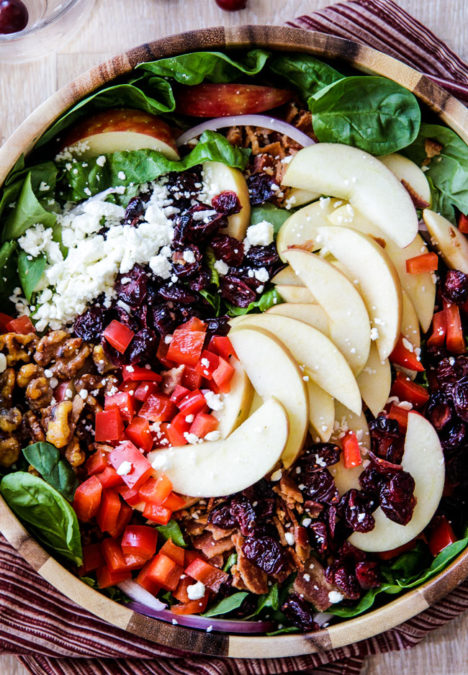
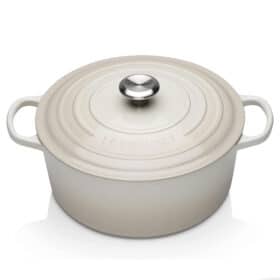
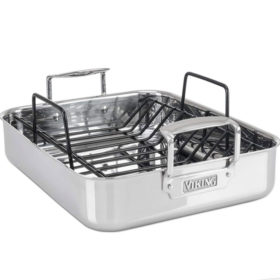
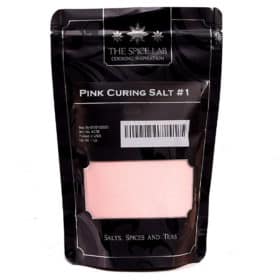
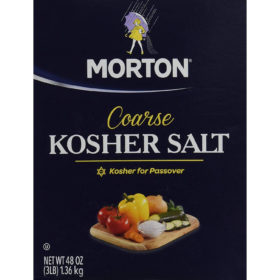

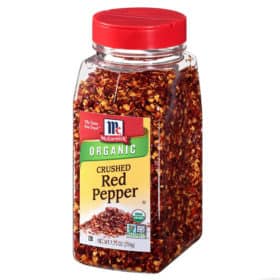
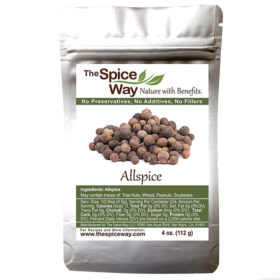
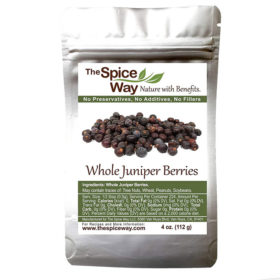
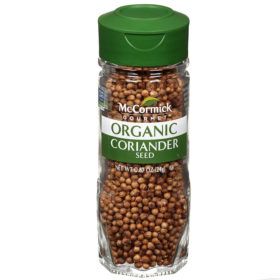
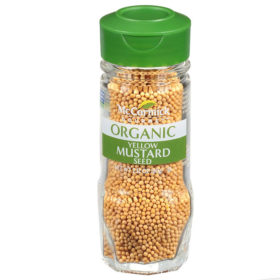

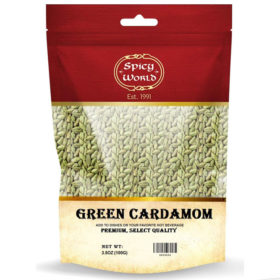
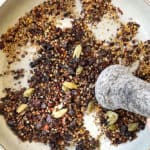
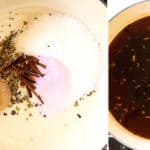



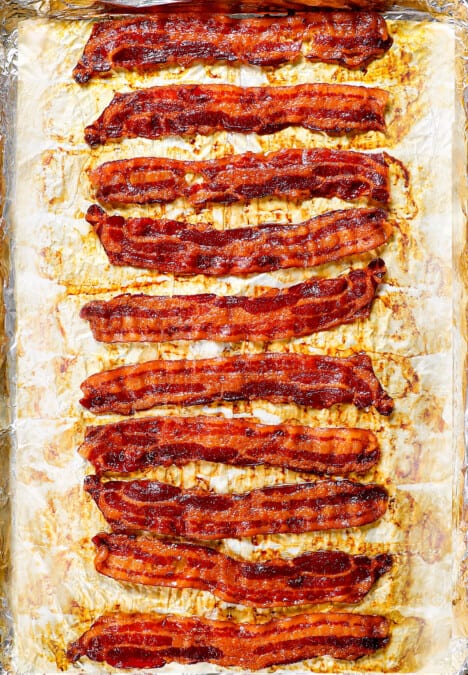
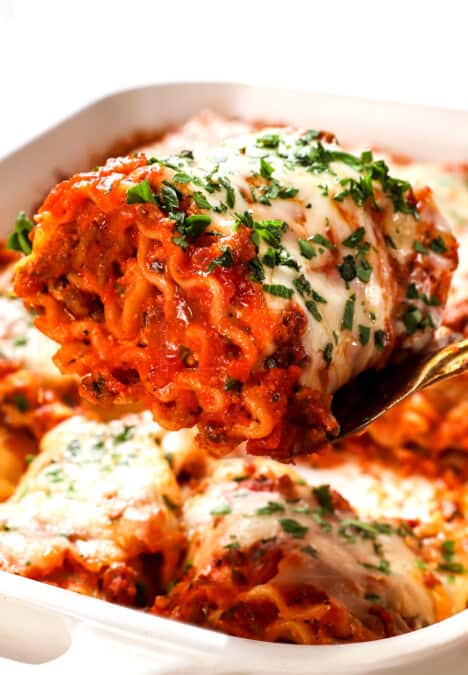
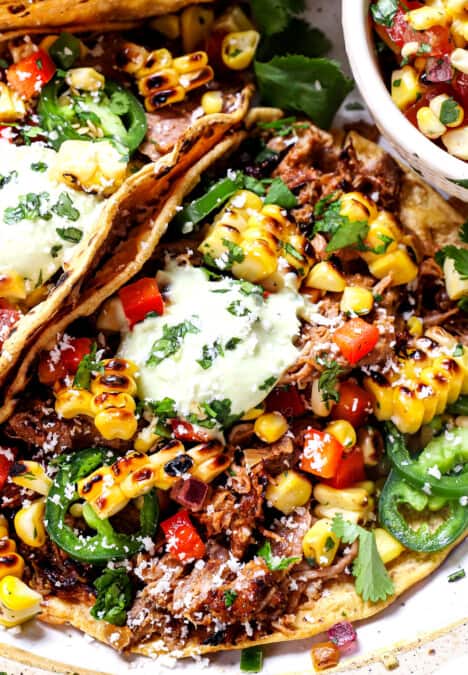
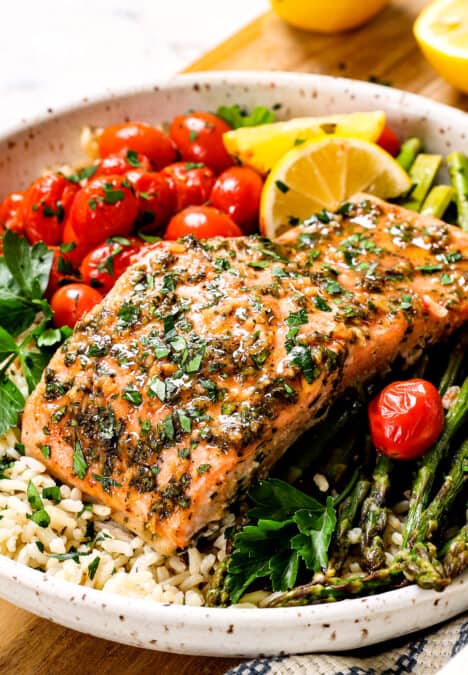
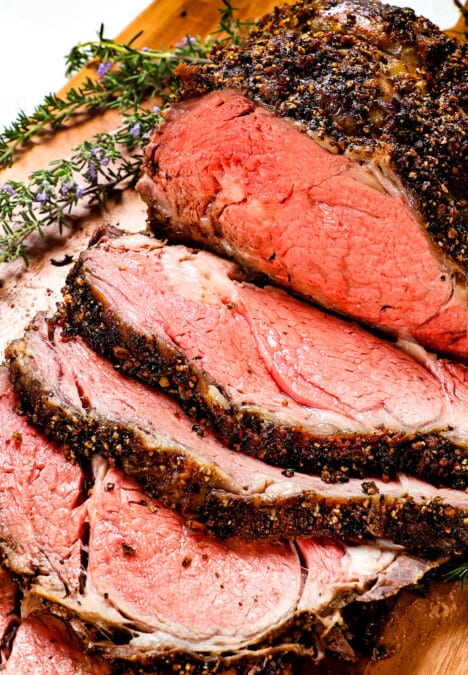
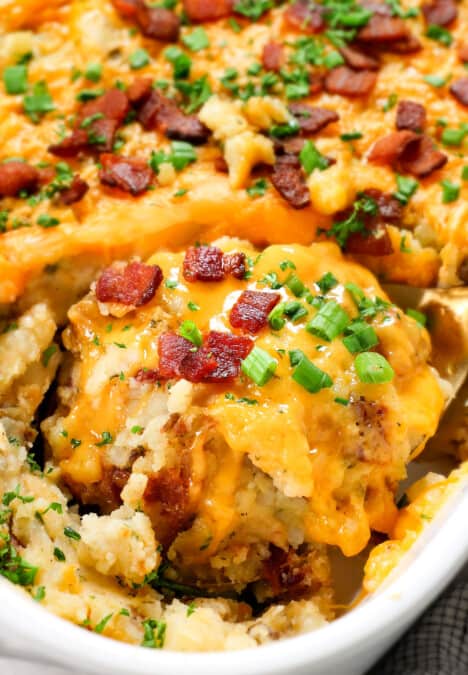























Ramya says
will be making this soon with few subs will dm you if i make this and let you know how it goes Thanks Ramya
Jen says
Sounds great, I hope you love it!
Anthony Wilburn says
Can you smoke this with wood on a grill? Thanks for your time.
Jen says
Absolutely!
Stephanie says
Great timing Jen! We recently bought a Traeger Ironwood 1300 smoker and I’ve been researching pastrami recipes because Ruben sandwiches are one of our favorites. Your recipe is spot on for brining. I grew up eating corned beef & the veggies but when I make it year after year for St Patty’s, regardless of what cooking method I’ve tried, my kids are less than impressed, haha. So this year going for an Irish Coddle or Irish stew but will definitely give your recipe a try too, it sounds amazing.
Jen says
So fun you got a Traeger, you are going to get so much use out if- perfect for pastrami! When you eventually make this recipe, I hope it finally makes corned beef lovers out of your kids!
Pam says
Hi Jen
This corned beef sounds wonderful! Unfortunately I had already purchased a 6# corned beef from Costco a few weeks ago. Could I use it and not do the brining? Just rinse it and go directly to your baking instructions on your recipe. (I will definitely try your method with just a beef brisket in the future).
I continue to make so many of your recipes and all have been outstanding!
Jen says
Absolutely! That will work great!
Julie Monroe says
Thank you for posting so many great recipes! Beside all the times you make a recipe and then tweak it to become even more delicious, the sheer time it takes to write up a recipe & anticipate questions, is incredible.
I cannot eat anything with nitrates/nitrites and have made my own corned beef that didn’t turn out so well, I will definitely try your method.
Your book is very compelling and informative. I teach at a 2-year community and transfer college in Wisconsin where I use a Wisconsin Author Project. Students get to choose a book, research the author’s life to make a poster presentation, then write an opinion paper about the book. Many of my students would like your book, but do you have a connection to Wisconsin or Minnesota? I’m hoping you do.
You are an incredible person with a lot of talent.
Jen says
Hi Julie, thank you so much for your kind words! I am so flattered students are interested in my book. I do have a connection to Wisconsin – my mom was born there! She lived there until she was 6 I believe. If you need more of a connection, I can ask how long her parents were there, etc. Thank you so much!
Julie Monroe says
Your mom’s connection works for me, so you will be one of my Wisconsin authors! Thank you for your reply. It made my day.
Jen says
Thanks Julie!
Laura says
Spot on directions, Jen. I used a Nathan’s corned beef, but I used your cooking directions for the oven (60 min/lb) and did the carrot and potatoes and honey mustard glaze as directed (I cooked cabbage separately as per picky family preference). Results were delicious. We all stuffed ourselves and are happy campers this St. Patty’s Day. Thank you!
Jen says
Thanks so much Laura, I’m so pleased this recipe worked perfectly with your Nathan’s corned beef and that the whole family loved it! It’s so fun to have a corned beef tradition!
Kristi says
I just came across this recipe, and would LOVE to make for St. Patrick’s Day- however, I realize I don’t quite have 5 days to cure the beef. Is this something that can still be made in just 3 days?
Jen says
Hi Kristi, the brine/flavor won’t be quite as strong with less time. I haven’t tasted it after 3 days, but I imagine it would still be tasty.